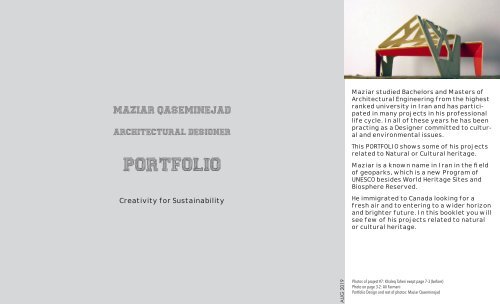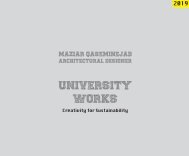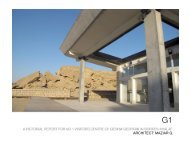PORTFOLIO Maziar
Maziar's Architectural Practices, Addressed Natural and Cultural Heritage Released between 2000 and 2015
Maziar's Architectural Practices, Addressed Natural and Cultural Heritage Released between 2000 and 2015
Create successful ePaper yourself
Turn your PDF publications into a flip-book with our unique Google optimized e-Paper software.
MAZIAR QASEMINEJAD<br />
Architectural Designer<br />
POrtfolio<br />
Creativity for Sustainability<br />
<strong>Maziar</strong> studied Bachelors and Masters of<br />
Architectural Engineering from the highest<br />
ranked university in Iran and has participated<br />
in many projects in his professional<br />
life cycle. In all of these years he has been<br />
practing as a Designer committed to cultural<br />
and environmental issues.<br />
This <strong>PORTFOLIO</strong> shows some of his projects<br />
related to Natural or Cultural heritage.<br />
<strong>Maziar</strong> is a known name in Iran in the field<br />
of geoparks, which is a new Program of<br />
UNESCO besides World Heritage Sites and<br />
Biosphere Reserved.<br />
He immigrated to Canada looking for a<br />
fresh air and to entering to a wider horizon<br />
and brighter future. In this booklet you will<br />
see few of his projects related to natural<br />
or cultural heritage.<br />
AUG 2019<br />
Photos of project #7: Khaleq Taheri exept page 7-3 (before)<br />
Photo on page 3-2: Ali Farmani<br />
Portfolio Design and rest of photos: <strong>Maziar</strong> Qaseminejad
1-1<br />
Geopark VISITOR CENTRE (g1)<br />
QESHM ISLAND UNESCO GLOBAL GEOPARK<br />
COMPLETED: OCT 2012<br />
IN 2016 GEOPARKS BECAME ONE OF THE PROGRAMS OF UNESCO BESIDES WORLD HERITAGE & BIOSPHERE RESERVED.
Qeshm Island located in a<br />
very hot and humid region,<br />
so the buildings consume<br />
large amounts of energy<br />
for chilling. My design dramatically<br />
reduced the power<br />
demand of the building<br />
because I applied some basic<br />
passive climatic design<br />
techniques, such as:<br />
• natural ventilating,<br />
• sun light controlling and<br />
using daylight<br />
• utilizing energy of soil,<br />
• installing double glazed<br />
windows,<br />
• collecting rainfall<br />
and drained water of<br />
air-conditioners,<br />
• isolating of all outer<br />
walls and the roof<br />
The main function of the<br />
building is serving visitors<br />
who come to this picturesque<br />
area, collecting<br />
information about other<br />
wonders of the island and<br />
the Geopark.<br />
Three local women manage<br />
the building and its yard, so<br />
they are allowed to sell the<br />
handicrafts of the ladies in<br />
the island to the tourists.<br />
The building presents information<br />
about the island<br />
including the concept of<br />
Geopark and covers their<br />
daily needs. It is probably<br />
the only sustainable modern<br />
structure within the<br />
island.<br />
The project was selected<br />
by the government as<br />
an exhibit in 56th Venice<br />
International Biennale of<br />
Arts, 2015.<br />
1-2
1-3<br />
The building is located in the entrance space of a Geosite<br />
in which is a must-see destination for visitors in<br />
a high-sensitive landscape. So, respecting the surrounding<br />
areas I hid it in a geological bowl not to distract<br />
the photos by the visitors.<br />
SITE PLAN
1-4
1-5
1-6
Geopark VISITOR CENTRE (g7)<br />
QESHM ISLAND UNESCO GLOBAL GEOPARK<br />
2-1
Simulation of persian garden<br />
PAVILION OF IRAN at BIT- 2016, MILAN, ITALY<br />
3-1
3-2<br />
BIT is one of the biggest exhibitions on<br />
Tourism Industry in the world. Our firm<br />
was invited to creative a concept that<br />
shows the attractions of new Iran. I<br />
took the idea from the symbol of paradise,<br />
Persian gardens which were<br />
historically closed to ordinary people<br />
for centuries, although they started to<br />
opened from 1900’s when the power of local governors declined. I lifted the traditional<br />
walls and put the information desks of the entities to communicate with<br />
their clients.<br />
The kiosk in the middle of the garden represents the vital springs and recalls the<br />
importance of water as the most important element of Persian gardens. The water<br />
was moving down until the main entrance where it absorbed the business people<br />
inside, towards the VIP room on the kiosk. The fact that we used real water and<br />
cedar, gave a dramatic feeling of Iranian tradition to the booth, according to the<br />
visitors.<br />
I used this concept to show European visitors<br />
that with the gates being opened, it was the<br />
time to visit Iran.
3-3
4-1<br />
revitalizing a forgotTEN fort of portuguESE<br />
QESHM ISLAND, IRAN, 2011<br />
The fort remains from 4 centuries ago as<br />
one of the important forts to control Hormuz<br />
strait. It has become an urban problem<br />
and the neighbors were always complaining<br />
to the local government that it should be<br />
demolished. So an archeological team started<br />
excavating it, they found some materials<br />
that told us interesting stories.<br />
Then the local government hired our firm to<br />
propose an idea to preserve the fort and<br />
we proposed to revitalize it to attract tourists.<br />
Most parts of the designed trails were<br />
never constructed because of lack of management<br />
but the fort opened to visitors and<br />
is an important tourist destination of the<br />
island today.
BEFORE<br />
AFTER<br />
4-2
PLAYGROUND, traditional wooden ships<br />
Design with PeopleQESHM ISLAND, IRAN, 2017<br />
A THEMATIC PLAYGROUND, QESHM ISLAND, IRAN<br />
ARCHITECT: MAZIAR QASEMINEJAD @ RECS Intl. Inc. 2017 This playground is located within<br />
an open-air museum recently<br />
implemented with support from<br />
JICA. I designed this playground<br />
with local carpenters to increase<br />
their self-awareness about<br />
their own assets and values and<br />
The Project funded<br />
by the Government of<br />
Japan and supported by<br />
the local Government of<br />
Iran (Qeshm Geopark),<br />
within a Pilot Project<br />
titled “Open Air<br />
Museum of Sailing and<br />
Traditional Wooden Ship<br />
Building in Qeshm Island”.<br />
It had persuaded the<br />
local community to understand,<br />
proud of, and<br />
preserve their unique<br />
ancestor’s skills as a<br />
strong heritage and asset,<br />
instead of copying<br />
neighboring villages.<br />
Sailing and shipbuilding<br />
in the Persian Gulf is<br />
an intangible heritage,<br />
under the auspice of<br />
UNESCO, that rooted in<br />
6,000 years of history.<br />
I proposed and designed<br />
Preliminary design<br />
changed during construction<br />
to adhere to the<br />
concept of Desgin with<br />
People!<br />
transfer it to next generation.<br />
The other reason was to welcome<br />
women to the shipyards<br />
that are traditionally banned to<br />
the women. Today, the women<br />
have started to sell their handicrafts<br />
and snacks to the tourists<br />
in the facilities next to the playground.<br />
I used wooden materials<br />
to enable them to show them<br />
their skills that can also be applied<br />
to other industries such as<br />
construction sectors.<br />
5-1<br />
this playground<br />
as one of my<br />
tasks under my<br />
assignment as<br />
a JICA Project<br />
expert. The idea<br />
was to involve<br />
the local carpenters<br />
from the<br />
planning stage<br />
until construction<br />
and operation.<br />
Thanks to those<br />
activities, the<br />
income of villagers<br />
increased<br />
3 times, and now<br />
they are confident,<br />
to establish<br />
a big sailing<br />
cruise.<br />
They’re looking<br />
for funds<br />
to complete the<br />
project including<br />
the revitalization<br />
of<br />
the water reservoir,<br />
installing<br />
the sails<br />
and slides, and<br />
planting the<br />
trees.<br />
The background<br />
photo shows inside<br />
of a real<br />
under-construction<br />
ship in the<br />
museum.
NEW city hall inside a world heritage SITE<br />
MAZANDARAN, IRAN, 2015<br />
6-1<br />
Persian Gardens are<br />
listed in UNESCO WHS.<br />
This garden is attached<br />
to one of the<br />
nine gardens of the<br />
list. The project did<br />
not proceed because<br />
the new councils believed<br />
the building<br />
should be located in<br />
front of the garden,<br />
but Department of<br />
Heritage disagreed.<br />
I drew all the 3Ds by<br />
SketchUp.
18 4<br />
1390 <br />
« »<br />
: <br />
6-2<br />
5<br />
: <br />
() <br />
18 5<br />
<br />
<br />
1390 <br />
. <br />
« »<br />
: <br />
- <br />
<br />
. <br />
- <br />
<br />
. <br />
... <br />
<br />
. <br />
. <br />
/<br />
. <br />
. <br />
<br />
. <br />
<br />
. <br />
. <br />
-1 1537 <br />
HISTORICAL STUDIES<br />
SAMPLE SHEET<br />
. 730<br />
<br />
<br />
1389 . <br />
1390 . : <br />
4<br />
1847 <br />
<br />
<br />
: <br />
. <br />
HISTORICAL STUDIES<br />
SAMPLE SHEET<br />
1390 . :
6-3<br />
MECHANICAL<br />
DRAWING SAMPLE<br />
ARCHITECTURAL DRAWING SAMPLE<br />
ARCHITECTURAL<br />
DRAWING SAMPLE<br />
ELECTRICAL<br />
DRAWING SAMPLE
Lightening and beautiFication of<br />
a rural CULTURAL landscape<br />
LOFT VILLAGE, QESHM ISLAND, IRAN, 2002 & 2003<br />
This project was<br />
delivered to prepare<br />
Loft village<br />
to host the 1 st<br />
and 2 nd festivals<br />
of art and<br />
culture of the<br />
coast-dwellers in<br />
Persian Gulf.<br />
Our firm was in<br />
charge of studying<br />
and finding a<br />
solution to make<br />
the whole village<br />
a kind of stage<br />
for the activities<br />
by the art or performance<br />
groups.
I lived 4 months in a local home to design in-site and lead<br />
the construction team, at the same time. It was a very successful<br />
project and Loft is a well-known rural destination in<br />
Iran thanks to the that festivals. The Department of Heritage<br />
listed the village as a Landscape Heritage Site and assigned<br />
good budget for its development, few years after our project<br />
was broadcast by media.<br />
7-2
BEFORE<br />
AFTER<br />
7-3
7-4
PUBLICATIONS<br />
Author of “Qeshm Eco-Island Master Plan for Next Generation, Plan 2036”<br />
24 Pages, Mah-o-Ma, Tehran, Iran, 2018<br />
A simplified form of the outputs of the Eco-Island Project for young students and others<br />
Author of “Let’s Play in Intertidal Areas; A Handbook for Environmental Education Along Shoreline”<br />
32 Pages, Mah-o-Ma, Tehran, Iran, 2018<br />
Co-author of “Traditional Architecture on Qeshm Island, Iran; Wind Catchers of Qeshm Island and Yazd, A Comparison”<br />
P49~ P53, (in English). 156 Pages, IVA-ICRA, Vienna, Austria, 2016<br />
Author of “A Summary of Master Plan of Qeshm Island Geopark”<br />
50 Pages, Mah-o-Ma, Tehran, 2013<br />
Member of the Research Team of Students to collect data. Title: “Maisons d’Ispahan”<br />
Maisonneuve et Larose Publication, Paris, 2001<br />
The research done in between 1996 and 1999, I was a selected student from U of Tehran<br />
Main author and research manager of “The Architecture of Loft Port, Qeshm Island”<br />
132 Pages, Qeshm Free Area Publications, Tehran, 2000<br />
maziarch@yahoo.com<br />
Mobile: +1 (343) 777 8944<br />
www.linkedin.com/in/maziarc





